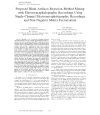Article
Analysis of Neurophysiological Reactions to Advertising Stimuli by Means of EEG and Galvanic Skin Response Measures
Journal of Neuroscience Psychology and Economics 01/2009; 2(1):21-31. DOI: 10.1037/a0015462
ABSTRACT
This article demonstrates how marketing may benefit from neurophysiology. The authors discuss a particular research case concerning the analysis of a skin care product advertisement. Pretests of 2 versions of this TV ad revealed that, although the versions were almost identical, each of them generated significantly different impact. Their influence was assessed using both cognitive measures (benefits and key benefits recall) and behavioral measures (shelf test). The only difference between these 2 versions of the ad was in a single scene that contained a particular gesture by a female model. Of note, the gesture appeared to enhance the effectiveness of the ad. The authors tested whether neurophysiological measures can capture differences in consumer reactions to slightly different marketing stimuli. Indeed, by using electroencephalography and electromyography and by monitoring skin conductance, the authors were able to register significant differences in neurophysiological reactions to an altered scene, even though the difference was not consciously seen. The authors believe that neurophysiological measures soon will be widely acknowledged and used as a complimentary method in classical marketing research.
Get notified about updates to this publication
Follow publication |
Data provided are for informational purposes only. Although carefully collected, accuracy cannot be guaranteed. The impact factor represents a rough estimation of the journal's impact factor and does not reflect the actual current impact factor. Publisher conditions are provided by RoMEO. Differing provisions from the publisher's actual policy or licence agreement may be applicable.
-
- "Wang and Minor (2008) summarized the validity, reliability and applicability of physiological techniques in marketing research, including eye movement, heart rate, blood pressure, facial muscle activity, voice pitch analysis and brain imaging. In such cases, the effectiveness of product form design may be evaluated by monitoring people's physiological activities resulting from observing/using different products (Khushaba et al., 2013; Ohme et al., 2009). A user's perceptions and responses to a product are mainly affected by the product's appearance (Ho and Lu, 2014). "
Full-text · Article · May 2016 · International Journal of Industrial Ergonomics -
- "Recently, a lot of research concerning biological signal analysis has been proceeded in various research fields. For example, the rehabilitation [1], [2], the neuromarketing [3], and the behavioral analysis [4]. Especially, research about electroencephalographic (EEG) signals has attracted attention since the EEG signal contains a mixture of endogenous brain activities. "
Full-text · Conference Paper · Mar 2014 -
- "Much neuromarketing research to this point has been focused on optimal methods to shift the distribution of choices (e.g., McClure et al., 2004; Santos et al. 2011; Ohme et al. 2009; Brauetigam et al. 2004). The use of " neuro " as a prefix has thus followed a similar rationale to that of neuroeconomics, whereby study of the neural processes provides a tool for describing behavioral change that was not available by the study of behavior alone (Ariely and Berns, 2010). "
Hans C Breiter · Martin Block · Anne J Blood · Bobby Calder · Laura Chamberlain · Nick Lee · Sherri Livengood · Frank J Mulhern · Kalyan Raman ·Don Schultz · Daniel B Stern · Vijay Viswanathan · Fengqing Zoe ZhangFull-text · Article · Jan 2014 · Frontiers in Human Neuroscience
Note: This list is based on the publications in our database and might not be exhaustive.











No comments:
Post a Comment